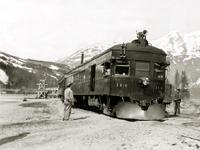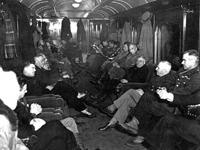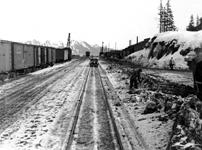 |
 |
 |
| Brill number 114 ran three times a week to Whittier. | Passengers are traveling
to the tunneling through ceremony. |
Rail yard in Whittier. |
A few from Bernadine Prince's book, the Alaska Railroad
| 1500 Man barracks, Whittier, Alaska. Photographer Gene Adoline was an enlisted man in the Army at Ft. Richardson in 1954. Of his photograph, he recalls, "Port Whittier Barracks had connecting tunnels which were used during the months that snow was bountiful. At the time this picture was taken (1954) the army would not let photographs be taken of this area as it was a very strategic area and the mountains behind these barracks were loaded with gun emplacements. Almost like Gibraltar." |
Where did
all those steam locomotives go? In January of 1958, the Norwegian heavy lift vessel the BELBETTY arrived in Whittier. Waiting there in storage were 14 retired Alaska Railroad steam locomotives bound for Spain. See pages 870-872 of Volume II Alaska Railroad by Bernadine Prince for the story and spotty photos. Retired locomotives were collected at Birchwood Yard and later moved to the Portage Yard where they were photographed in early spring 1956. Carol Elovirta of Naples Florida, recently visited Whittier after 51 years absence. She was a young married military dependent in 1956 and lived next door to the Durand family in the old Whittier trailer court. She shared a number of photographs from those days in Whittier that railroaders will find of interest. The originals were badly faded color slides that were computer enhanced. These locomotives were moved into Whittier in 1957 and stored on one yard lead near Colombia Lumber Co. Art Gibson also photographed this line up when it was in Whittier. No. 401, the 402, the 403, the 405, the 406, the 552, the 555 the 558, the 559 and the 560 all consolidations were loaded aboard. The remains of 701, The 702, the 703 and the 902 completed the load on the BELBETTY destined for the Port of Gijon, Spain for service on the 40 mile long Ferroccarril de Langreo in the Province of Asturias. During the post war reconstruction of the Alaska Railroad there was another scrap drive that resulted in retired locomotives moving to Whittier from Birchwood. On page 725 of Volume II Alaska Railroad by Prince there are photos from the Frank O'Donnell collection, courtesy of Dennis O'Neil. These photos show the remains of 756 (sic) but there was no mike by that number, so it is probably #751 an ex NP Loco scraped in 1947. Loco 4073 an Army switcher, misidentified in the caption as 473 is in the train. Two of the original Panama moguls, one from each class, 606, 280 lead the train in tow behind a 550 class Consolidation. These locomotives probably became granddad's Chevrolet. |
Pat Durand provided us with some excerpts regarding Whittier from Bernadine
Prince's book, The Alaska Railroad:
Page 658: "The first passenger was run through the Whittier tunnels on March 10 when the Alaska Railroad Brill Car No. 114 and trailer, with Engineer Frank O'Donnell at the controls, and Conductor John N. Rothy in charge of the train."
Pages 675-677: There are photos of Locos 1001 and 1000 with dignitaries and train crews in Anchorage and Whittier. The first run by these locomotives was on June 15, 1944. The Whittier Depot was complete and operational on their arrival. Engineer George Moore, Conductor W.P. Burgan, Maurice Scott, Wayne Ware and a member of the 714th made up the crew and they are pictured on page 676. The locomotives arrived in Whittier on June 9th and were towed to Anchorage to be prepared for service.
Page 692: (comment: This reference is to the operations of the 714th Railway Operating Bn and only relates to transportation functions and assets. The Alaskan Command continued with its combined force mission in Whittier, with Navy, MSTS, and Army personnel). "Under and agreement with the Army, The Alaska Railroad took over all operations at Whittier on December 17,1945, replacing soldier forces there. All mechanized equipment, supplies and buildings not already owned by the Railroad were either transferred or loaned to the Railroad. The Army also released 85 enlisted men for employment by the Railroad as longshoremen".
Page 696: Early in March 1946, the Port of Whittier was closed because of the decrease in military traffic, and such traffic was handled through Seward.
Page 697: The Seward Army Dock was closed on September 11 and the Railroad took over its operation. Army personnel moved to Whittier and opened that port again on September 12. Task Force "Frigid", experimental group of 1400 troops, arrived on September 12 at Whittier.
These photographs are from Ken Reuben's 1944-45 tour of duty in Alaska.